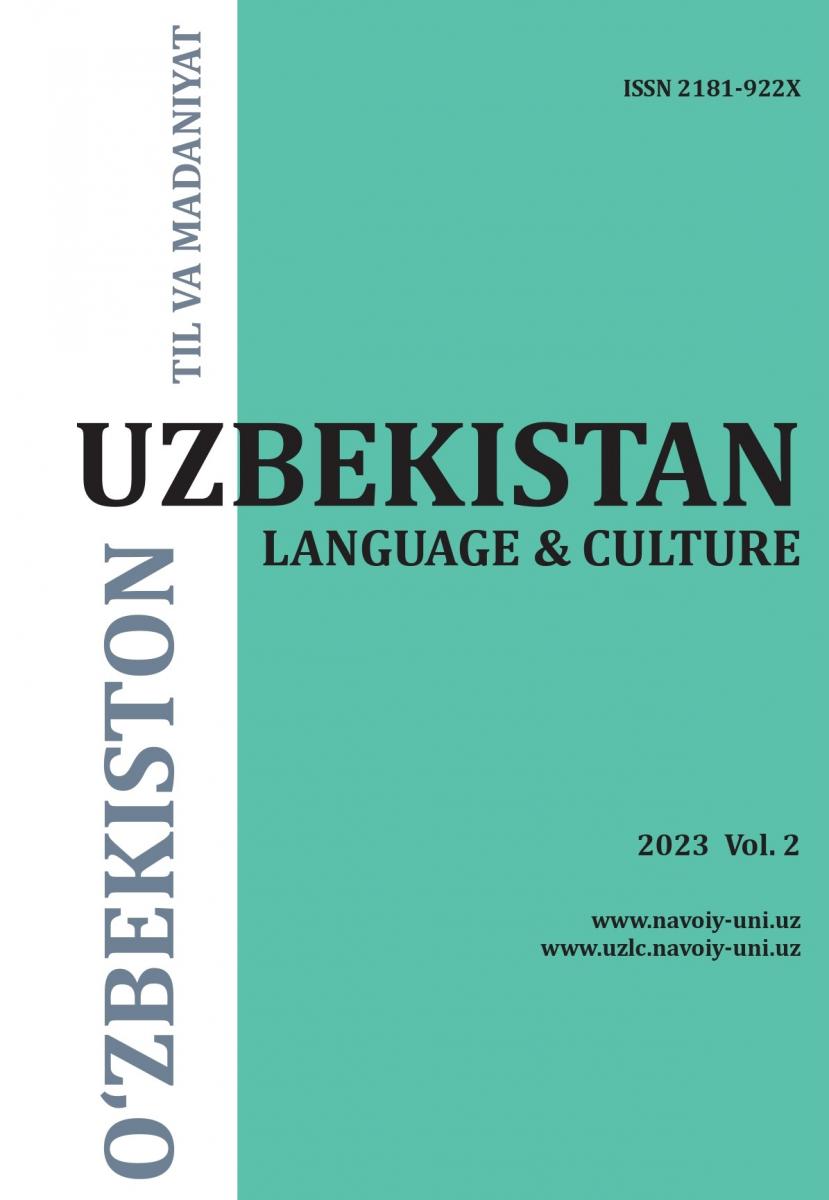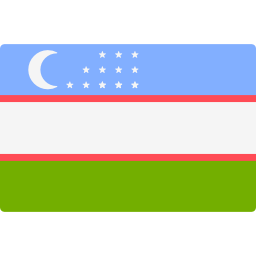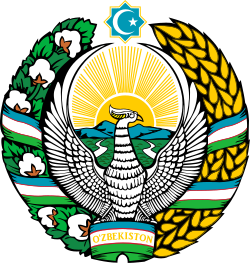Uzbekistan: Language and Culture
 | The journal “Uzbekistan: Language and Culture” was registered on october 26, 2017 by the press and Information agency of the Republic of Uzbekistan (certificate № 0936). Founder of the journal: Tashkent State University of Uzbek Language and Literature named after Alisher Navoi. International standard serial number - ISSN 2181-922X “Uzbekistan: Language and Culture” is an academic journal that publishes works in the field of linguistics, history, literature, translation studies, arts, ethnography, philosophy, anthropology and social studies. The journal is published four times a year. The purpose of the journal is to publish the results of the latest research that are rich in new, innovative ideas and has its own concept, which stimulates debate on topical issues in these areas. The language of articles can be English, Russian and Uzbek. Other Turkic languages are also welcome. We do not publish economic analyses or political articles. In addition to research articles, the journal announces book and literary work reviews, conference reports and research project results. The authors’ ideas may differ from those of the editors’. Xalqaro standart seriya raqami - ISSN 2181-922X The following articles are published in the journal "Uzbekistan: Language and Culture": 1. Linguistics. 2. Literature. Translation Studies. 3. Religion. Philosophy. Theology. 4. Science. Education. Methodology. 5. Sociology. Psychology. 6. History. Source studies. 7. Ethnology. Ethnography. Anthropology. 8. Art. Journal site: https://uzlc.tsuull.uz/index.php/uzlangcult |
EDITOR-IN-CHIEF: Shuhrat Sirojiddinov | DEPUTY EDITORS IN CHIEF: Zaynobiddin Abdirashidov Qosimboy Ma’murov | EXECUTIVE SECRETARY: Ozoda Tojiboyeva |
EDITORIAL BOARD
Ahmadali Asqarov, Abdulaziz Mansur, Akmal Saidov, Akmal Nur, Adham Ashirov, Nizomiddin Mahmudov, Hamidulla Dadaboyev, Samixon Ashirboyev, Bahodir Karimov, Aftondil Erkinov, Baxtiyor Mengliyev, Uzoq Jo‘raqulov, Sulton Normamatov, Murtazo Sayidumarov, G‘aybulla Boboyorov, Nozliya Normurodova, Abdi Mamatov, Nodirbek Jo‘raqo‘ziyev, Anvar Sayfullayev.
EDITORIAL COMMITTEE
Isa Habibbeyli (Azerbaijan), Frederik Bressand (France), Ingeborg Baldauf (Germany), Mark Toutant (France), Rochelle Almeida (USA), Akrom Habibullayev (USA), Valeriy S. Xan (Uzbakistan), Eunkyung Oh (South Korea), Oqilxon Ibrohimov (Uzbakistan), Shodmon Vohidov (Tajikistan), Maria Sabtelni (Canada), Timur Kocaoğlu (USA), Almaz Ülvi (Azerbaijan), Tanju Seyhan (Turkey), Xisao Komatsu (Japan), Emek Üşenmez (Turkey), Abdulvahap Kara (Turkey), Alizoda Saidumar (Tajikistan), Dilorom Ashurova (Uzbakistan), Darya Jigulskaya (Russia)
SUBMISSION PREPARATION CHECKLIST
As part of the submission process, authors are required to check off their submission's compliance with all of the following items, and submissions may be returned to authors that do not adhere to these guidelines.
The Chicago Manual of Style provides two documentation systems: the notes and
bibliography style (p. 1 3) and the author-date style (p. 4-6). For numerous specific examples,
see chapters 14/15 of The Chicago Manual of Style, 16th edition.
NOTES & BIBLIOGRAPHY SYSTEM
The following examples illustrate citations using the notes and bibliography style. Examples of
first notes are followed by shortened versions of subsequent citations to the same source. For
examples of the same citations using the author-date system, See page 4, below.
BOOK
Reference (hanging indent) for book:
Ward, Geoffrey C., and Ken Burns. The War: An Intimate History of the Second World War, 1941–1945.
New York: Knopf, 2007.
First note (indented):
Geoffrey C. Ward and Ken Burns, The War: An Intimate History, 1941–1945 (New York: Knopf,
2007), 52.
Ibid or subsequent note (indented):
Ward and Burns, War, 59–61.
For four or more authors, list all of the authors in the bibliography; in the note, list only the first
author, followed by et al. (“and others”) as in this example:
Reference (hanging indent) for book chapter:
Kelly, John D, et al. “Seeing Red: Mao Fetishism, Pax Americana, and the Moral Economy of War.” In
Anthropology and Global Counterinsurgency, edited by John D. Kelly, John Marshall, Abigial
Adamas, Josepgone Tey, and Mickey Spillane, 67–83. Chicago: University of Chicago Press,
2010.
First note (indented):
John D. Kelly, et al, “Seeing Red: Mao Fetishism, Pax Americana, and the Moral Economy of
War,” in Anthropology and Global Counterinsurgency, ed. John D. Kelly, et al. (Chicago: University of
Chicago Press, 2010), 77.
Ibid or subsequent note (indented):
Kelly, “Seeing Red,” 81–82.
BOOK PUBLISHED ELECTRONICALLY
If available in more than one format, cite the version. For online books, list URL; include an
access date only if one is required by your discipline. If no fixed page numbers are available,
include a section title or chapter or other number.
Austen, Jane. Pride and Prejudice. New York: Penguin Classics, 2007. Kindle edition.
First note (indented):
Jane Austen, Pride and Prejudice (New York: Penguin Classics, 2007), Kindle edition.
Ibid or subsequent note (indented):
Austen, Pride and Prejudice.
Reference (hanging indent) for web e-version:
Kurland, Philip B., and Ralph Lerner, eds. The Founders’ Constitution. Chicago: University of Chicago
Press, 1987. Accessed February 28, 2010. http://press-pubs.uchicago.edu/founders/.
First note (indented):
Philip B. Kurland and Ralph Lerner, eds., The Founders’ Constitution (Chicago: University of
Chicago Press, 1987), accessed February 28, 2010, http://press-pubs.uchicago.edu/founders/.
Ibid or subsequent note (indented):
Kurland and Lerner, Founder’s Constitution, chap. 10, doc. 19.
JOURNAL ARTICLE
Article in a print journal
In the bibliography, list the page range for the whole article. In a note, list the specific page
numbers as consulted.
Reference (hanging indent):
Weinstein, Joshua I. “The Market in Plato’s Republic.” New Republic 104 (2009): 439–58.
First note (indented):
Joshua I. Weinstein, “The Market in Plato’s Republic,” Classical Philology
104 (2009): 440.
Ibid or subsequent note (indented):
Weinstein, “Plato’s Republic,” 452–53.
Article in an online journal
Include a DOI if the journal lists one. A DOI is a permanent ID that, when appended to
http://dx.doi.org/ in the address bar of an Internet browser, will lead to the source. If no DOI is
available, list a URL. Include an access date only if one is required by your discipline.
Kossinets, Gueorgi, and Duncan J. Watts. “Origins of Homophily in an Evolving Social Network.”
American Journal of Sociology 115 (2009): 405–50. doi:10.1086/599247.
First note (indented):
Gueorgi Kossinets and Duncan J. Watts, “Origins of Homophily in an Evolving Social Network,”
American Journal of Sociology 115 (2009): 411, doi:10.1086/599247.
Ibid or subsequent note (indented):
Kossinets and Watts, “Origins of Homophily,” 439.
Article in a newspaper or popular magazine
Newspaper and magazine articles may be cited in running text (“As Sheryl Stolberg and Robert
Pear noted in a New York Times article on February 27, 2010…”); they are commonly omitted
from a reference list. The following examples show the more formal versions of citations. If you
consulted the article online, include a URL; include an access date only if your discipline
requires one. If no author is identified, begin the citation with the article title.
Bibliography (hanging indent):
Stolberg, Sheryl Gay, and Robert Pear. “Wary Centrists Posing Challenge in Health Care Vote.” New
York Times, February 27, 2010. http://www.nytimes.com/28/us/28health.html.
First note (indented):
Sheryl Gay Stolberg and Robert Pear, “Wary Centrists Posing Challenge in Health Care Vote,”
New York Times, February 27, 2010, http://www.nytimes.com//02/28/us/lth.html.
Ibid or subsequent note (indented):
Stolberg and Pear, “Wary Centrists.”
WEBSITE
A citation to website content can often be limited to a mention in the text or in a note (“As of July
19, 2008, the McDonald’s Corporation listed on its website . . .”). If a more formal citation is
desired, it may be cited as in the examples below. Because such content is subject to change,
include an access date or, if available, a date that the site was last modified.
Bibliography (hanging indent):
Google. “Google Privacy Policy.” Accessed July 19, 2010.
http://www.google.com/intl/en/privacypolicy.html.
First note (indented):
“Google Privacy Policy,” last modified March 11, 2009,
http://www.google.com/intl/en/privacypolicy.html.
Ibid or subsequent note (indented):
“Google Privacy Policy.”
The following examples illustrate citations using the author-date system. Each example of a
reference list entry is accompanied by an example of a corresponding parenthetical citation in
the text. For more details and many more examples, see chapter 15 of The Chicago Manual of
Style.
BOOK
Reference List (hanging indent):
Pollan, Michael. 2006. The Omnivore’s Dilemma: A Natural History of How Eating Has Evolved. New
York: Penguin.
In Text Cite:
(Pollan 2006, 99–100)
Reference List (hanging indent):
Ward, Geoffrey C., and Ken Burns. 2007. The War: An Intimate History, 1941–1945. New York: Knopf.
In Text Cite:
(Ward and Burns 2007, 52)
For four or more authors, list all of the authors in the reference list; in the text, list only the first
author, followed by et al. (“and others”):
(Barnes et al. 2010, 847)
Reference List (hanging indent) book chapter:
Kelly, John D. 2010. “Seeing Red: Mao Fetishism, Pax Americana, and the Moral Economy of War.” In
Anthropology and Global Counterinsurgency, edited by John D. Kelly, Beatrice Jauregui, Sean T.
Mitchell, and Jeremy Walton, 67–83. Chicago: University of Chicago Press.
In Text Cite:
(Kelly 2010, 77)
Chapter of an edited volume originally published elsewhere (as in primary sources):
Reference List (hanging indent) book originally published elswehre:
Cicero, Quintus Tullius. 1986. “Handbook on Canvassing for the Consulship.” In Rome: Late Republic
and Principate, edited by Walter Emil Kaegi Jr. and Peter White. Vol. 2 of University of Chicago
Readings in Western Civilization, edited by John Boyer and Julius Kirshner, 33–46. Chicago:
University of Chicago Press. Originally published in Evelyn S. Shuckburgh, trans., The Letters of
Cicero, vol. 1 (London: George Bell & Sons, 1908).
In Text Cite:
(Cicero 1986, 35)
5
BOOK PUBLISHED ELECTRONICALLY
If a book is available in more than one format, cite the version you consulted. For books
consulted online, list a URL; include an access date only if one is required by your discipline. If
no fixed page numbers are available, you can include a section title or a chapter or other
number.
Reference List (hanging indent):
Austen, Jane. 2007. Pride and Prejudice: A Novel in Five Books. New York: Penguin Classics. Kindle
edition.
In Text Cite:
(Austen 2007, 101)
Reference List (hanging indent):
Kurland, Philip B., and Ralph Lerner, eds. 1987. The Founders’ Constitution. Chicago: University of
Chicago Press. http://press-pubs.uchicago.edu/founders/.
In Text Cite:
(Kurland and Lerner, chap. 10, doc. 19)
JOURNAL ARTICLE
Article in a print journal
In the text, list the specific page numbers consulted, if any. In the reference list entry, list the
page range for the whole article.
Reference List (hanging indent):
Weinstein, Joshua I. 2009. “The Market in Plato’s Republic.” Classical Philology 104:439–58.
In text cite:
(Weinstein 2009, 440)
Article in an online journal
Include a DOI if the journal lists one. A DOI is a permanent ID that, when appended to
http://dx.doi.org/ in the address bar of an Internet browser, will lead to the source. If no DOI is
available, list a URL. Include an access date only if one is required by your discipline.
Reference List (hanging indent):
Kossinets, Gueorgi, and Duncan J. Watts. 2009. “Origins of Homophily in an Evolving Social Network.”
American Journal of Sociology 115:405–50. doi:10.1086/599247.
In text cite:
(Kossinets and Watts 2009, 411)
Newspaper and magazine articles may be cited in running text (“As Sheryl Stolberg and Robert
Pear noted in a New York Times article on February 27, 2010…”); they are commonly omitted
from a reference list. The following examples show more formal versions of the citations. If you
consulted the article online, include a URL; include an access date only if your discipline
requires one. If no author is identified, begin the citation with the article title.
Reference List (hanging indent):
Mendelsohn, Daniel. 2010. “But Enough about Me.” New Yorker, January 25.
In text cite:
(Mendelsohn 2010, 68)
Reference List (hanging indent):
Stolberg, Sheryl Gay, and Robert Pear. 2010. “Wary Centrists Posing Challenge in Health Care Vote.”
New York Times, February 27. http://www.nytimes.com/2010/02/28/us/politics/28health.html.
In text cite:
(Stolberg and Pear 2010, 12)
WEBSITE
A citation to website content can often be limited to a mention in the text (“As of July 19, 2008,
the McDonald’s Corporation listed on its website . . .”). If a more formal citation is desired, it may
be cited as in the examples below. Because such content is subject to change, include an
access date or, if available, a date that the site was last modified. In the absence of a date of
publication, use the access date or last-modified date as the basis of the citation.
Bibliography (hanging indent):
Google. 2009. “Google Privacy Policy.” Last modified March 11.
http://www.google.com/intl/en/privacypolicy.html.
In text cite:
(Google 2009)
Reference List (hanging indent):
McDonald’s Corporation. 2008. “McDonald’s Happy Meal Toy Safety Facts.”
http://www.mcdonalds.com/corp/about/factsheets.html.
In text cite:
(McDonald’s 2008)




